Below are a few questions that I have received regarding Advent.
What I share here (and on my blog in general) is an accumulation of what I’ve gathered in my 25 years of motherhood, 15 years following the Traditional Calendar within a wonderful Traditional Latin Mass parish. I have not arrived. But I continue to learn and grow as we journey home.
I believe that it’s not necessary to drop extra money in order to live the Liturgical Life well. At the bare minimum, invest in a good Missal, Bible, Traditional Catechism, and a few spiritual reading books that you can cycle through. Purchase other things as you’re able or your gifts warrant. Do not get caught up with materialism of the present day Liturgical Living trends. And do not feel compelled to adopt gifts which do not come natural do you. Trust that you have the grace to give your children everything they need without copying someone else’s family plan.
Please take what you can to be encouraged as you discern what God is asking of you this Advent. 💜
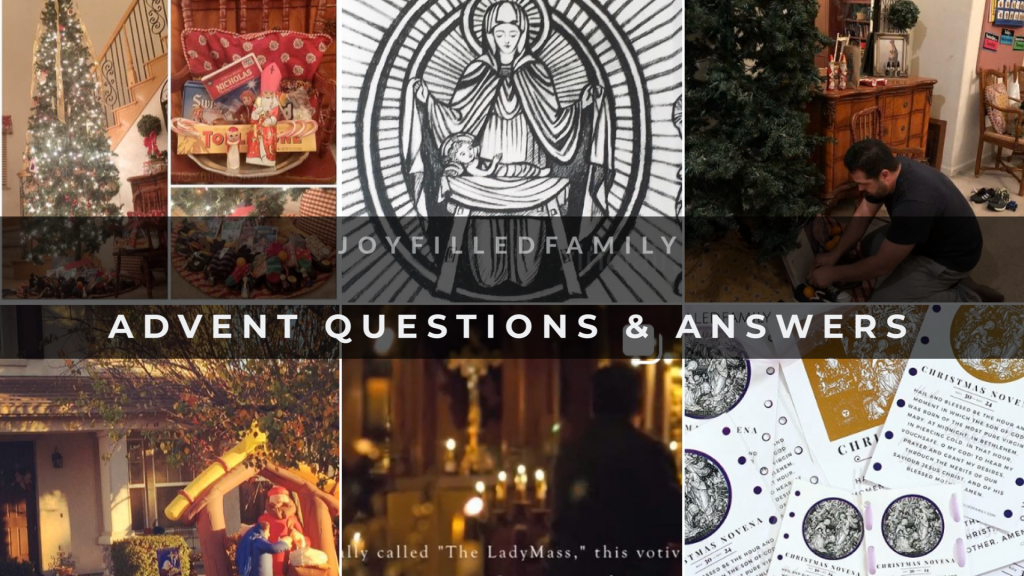
When does Advent begin?
Advent begins on the Sunday closest to St. Andre’s Day (Nov. 30), before or after.
Christmas begins with the Midnight Mass. Liturgically, the Christmas season ends on the feast of the Presentation of Christ in the Temple and Our Lady’s Purification, on February 2nd.
What is the length of the Christmas Season?
Simeon and the prophetess, Anna (Luke 2). The days from the Feast of the Nativity to the Epiphany are known as “The Twelve Days of Christmas,” with Christmas itself being the first day, and Twelfthnight — 5 January — being the last of the twelve days. Christmastide liturgically ends on 13 January, the Octave of the Epiphany and the Baptism of Christ (at which time the season of Time After Epiphany begins). But Christmas doesn’t end spiritually — i.e., the celebration of the events of Christ’s life as a child don’t end, and the great Christmas Cycle doesn’t end — until Candlemas on 2 February and the beginning of the Season of Septuagesima. -Fisheaters
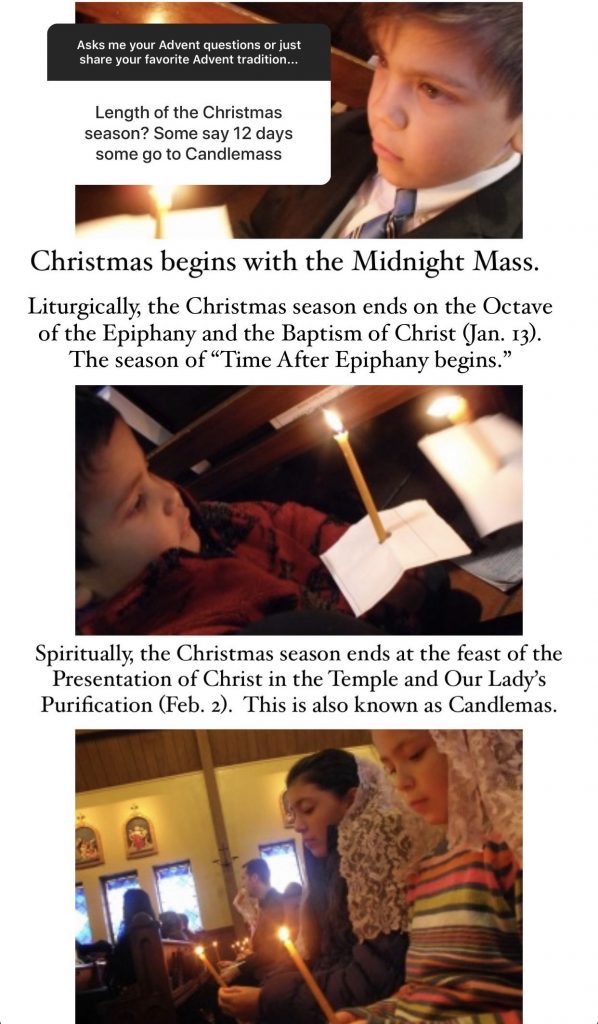
Do you fast during Advent like Lent?
The explanation below is taken from The Liturgical Year by Dom Gueranger.
We must look upon Advent in two different lights: first, as a time of preparation, properly so called, for the birth of our Saviour, by works of penance; and secondly, as a series of ecclesiastical Offices drawn up for the same purpose. We find, as far back as the fifth century, the custom of giving exhortations to the people in order to prepare them for the feast of Christmas. We have two sermons of Saint Maximus of Turin on this subject, not to speak of several others which were formerly attributed to St. Ambrose and St. Augustine, but which were probably written by St. Cesarius of Aries. If these documents do not tell us what was the duration and what the exercises of this holy season, they at least show us how ancient was the practice of distinguishing the time of Advent by special sermons. Saint Ivo of Chartres, St. Bernard, and several other doctors of the eleventh and twelfth centuries, have left us set sermons de Adventu Domini, quite distinct from their Sunday homilies on the Gospels of that season. In the capitularia of Charles the Bald, in 846, the bishops admonish that prince not to call them away from their Churches during Lent or Advent, under pretext of affairs of the State or the necessities of war, seeing that they have special duties to fulfil, and particularly that of preaching during those sacred times.
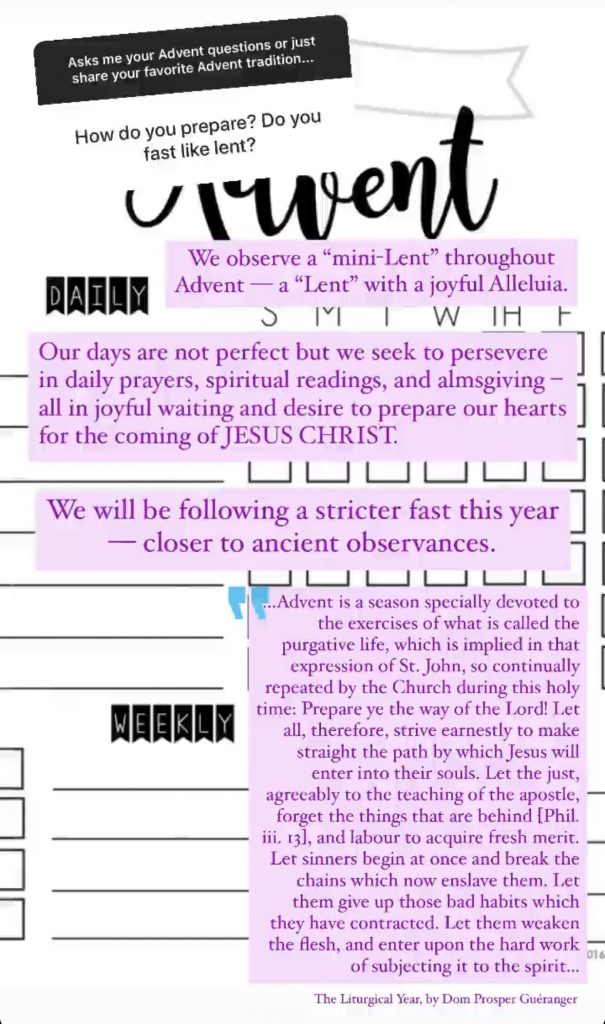
The oldest document in which we find the length and exercises of Advent mentioned with anything like clearness, is a passage in the second book of the History of the Franks by St. Gregory of Tours, where he says that St. Perpetuus, one of his predecessors, who held that see about the year 480, had decreed a fast three times a week, from the feast of St. Martin until Christmas. It would be impossible to decide whether St. Perpetuus, by his regulations, established a new custom, or merely enforced an already existing law. Let us, however, note this interval of forty, or rather of forty-three days, so expressly mentioned, and consecrated to penance, as though it were a second Lent, though less strict and severe than that which precedes Easter.
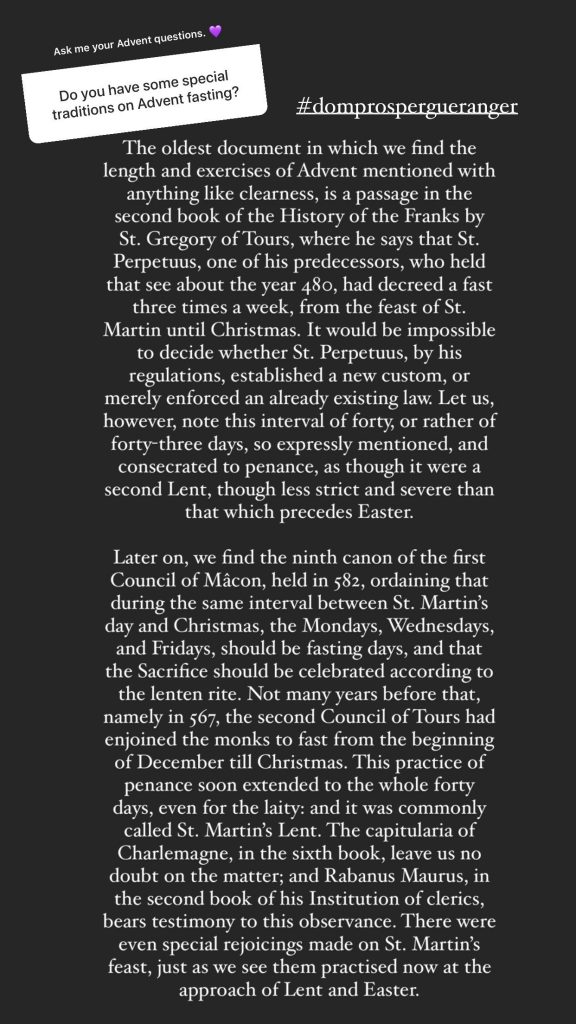
Later on, we find the ninth canon of the first Council of Mâcon, held in 582, ordaining that during the same interval between St. Martin’s day and Christmas, the Mondays, Wednesdays, and Fridays, should be fasting days, and that the Sacrifice should be celebrated according to the lenten rite. Not many years before that, namely in 567, the second Council of Tours had enjoined the monks to fast from the beginning of December till Christmas. This practice of penance soon extended to the whole forty days, even for the laity: and it was commonly called St. Martin’s Lent. The capitularia of Charlemagne, in the sixth book, leave us no doubt on the matter; and Rabanus Maurus, in the second book of his Institution of clerics, bears testimony to this observance. There were even special rejoicings made on St. Martin’s feast, just as we see them practised now at the approach of Lent and Easter.
The obligation of observing this Lent, which, though introduced so imperceptibly, had by degrees acquired the force of a sacred law, began to be relaxed, and the forty days from St. Martin’s day to Christmas were reduced to four weeks. We have seen that this fast began to be observed first in France; but thence it spread into England. as we find from Venerable Bede’s history; into Italy, as appears from a diploma of Astolphus, king of the Lombards, dated 753; into Germany, Spain, &c., of which the proofs may be seen in the learned work of Dom Martène, On the ancient rites of the Church. The first allusion to Advent’s being reduced to four weeks is to be found in the ninth century, in a letter of Pope St. Nicholas I to the Bulgarians. The testimony of Ratherius of Verona, and of Abbo of Fleury, both writers of the tenth century, goes also to prove that, even then, the question of reducing the duration of the Advent fast by one-third was seriously entertained. It is true that St. Peter Damian, in the eleventh century, speaks of the Advent fast as still being for forty days; and that St. Louis, two centuries later, kept it for that length of time; but as far as this holy king is concerned, it is probable that it was only his own devotion which prompted him to this practice.
The discipline of the Churches of the west, after having reduced the time of the Advent fast, so far relented, in a few years, as to change the fast into a simple abstinence; and we even find Councils of the twelfth century, for instance Selingstadt in 1122, and Avranches in 1172, which seem to require only the clergy to observe this abstinence. The Council of Salisbury, held in 1281, would seem to expect none but monks to keep it. On the other hand (for the whole subject is very confused, owing, no doubt, to there never having been any uniformity of discipline regarding it in the western Church), we find Pope Innocent III, in his letter to the bishop of Braga, mentioning the custom of fasting during the whole of Advent, as being at that time observed in Rome; and Durandus, in the same thirteenth century, in his Rational on the Divine Offices, tells us that, in France, fasting was uninterruptedly observed during the whole of that holy time.
This much is certain, that, by degrees, the custom of fasting so far fell into disuse, that when, in 1362, Pope Urban V endeavoured to prevent the total decay of the Advent penance, all he insisted upon was that all the clerics of his court should keep abstinence during Advent, without in an way including others, either clergy or laity, in this law. St. Charles Borromeo also strove to bring back his people of Milan to the spirit, if not to the letter, of ancient times. In his fourth Council, he enjoins the parish priests to exhort the faithful to go to Communion on the Sundays, at least, of Lent and Advent; and afterwards addressed to the faithful themselves a pastoral letter, in which, after having reminded them of the dispositions wherewith they ought to spend this holy time, he strongly urges them to fast on the Mondays, Wednesdays, and Fridays, at least, of each week in Advent. Finally, Pope Benedict XIV, when archbishop of Bologna, following these illustrious examples, wrote his eleventh Ecclesiastical Institution for the purpose of exciting in the minds of his diocesans the exalted idea which the Christians of former times had of the holy season of Advent, and of removing an erroneous opinion which prevailed in those parts, namely, that Advent concerned religious only and not the laity. He shows them that such an opinion, unless it be limited to the two practices of fasting and abstinence, is, strictly speaking, rash and scandalous, since it cannot be denied that, in the laws and usages of the universal Church, there exist special practices, having for their end to prepare the faithful for the great feast of the birth of Jesus Christ.

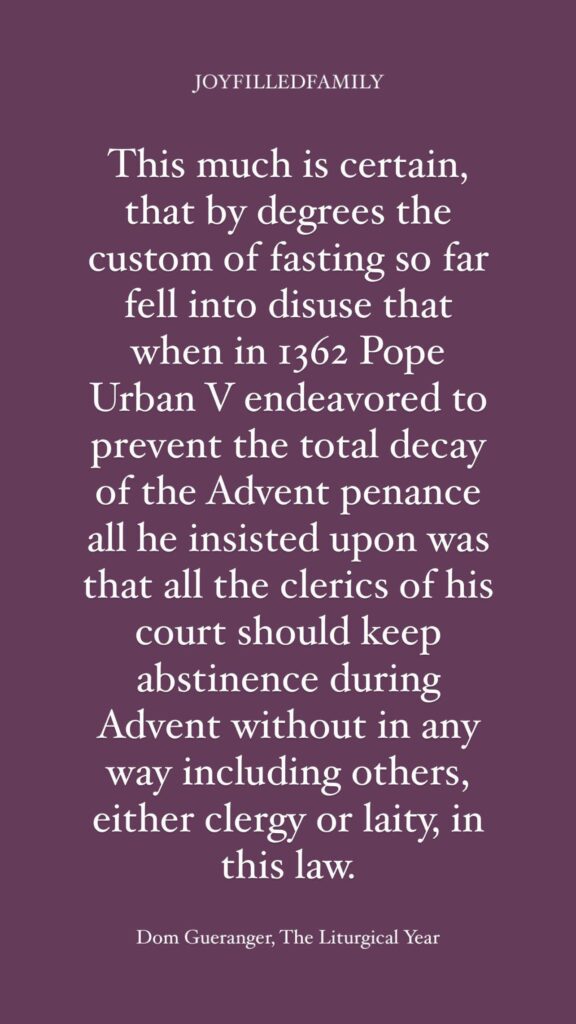

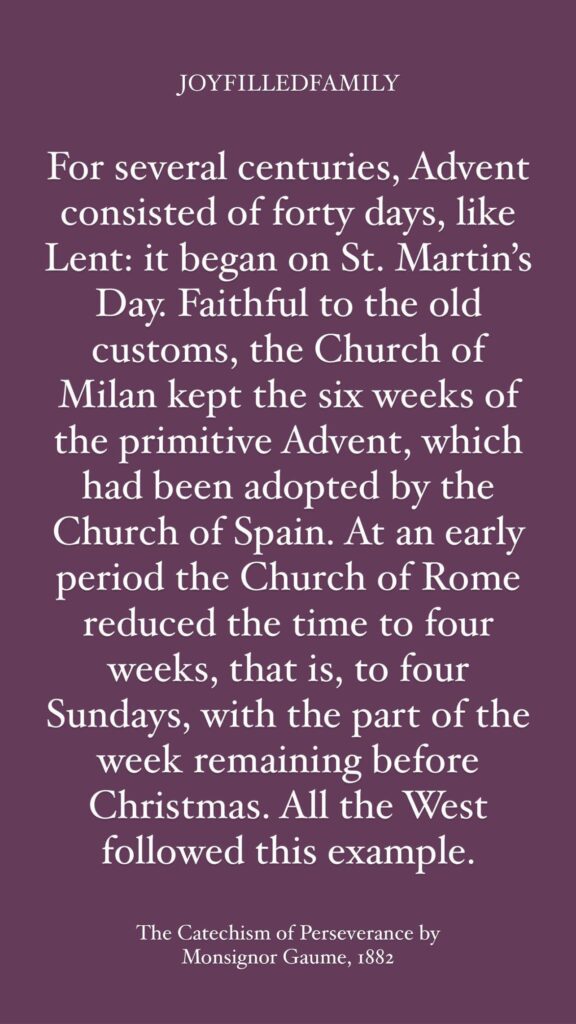
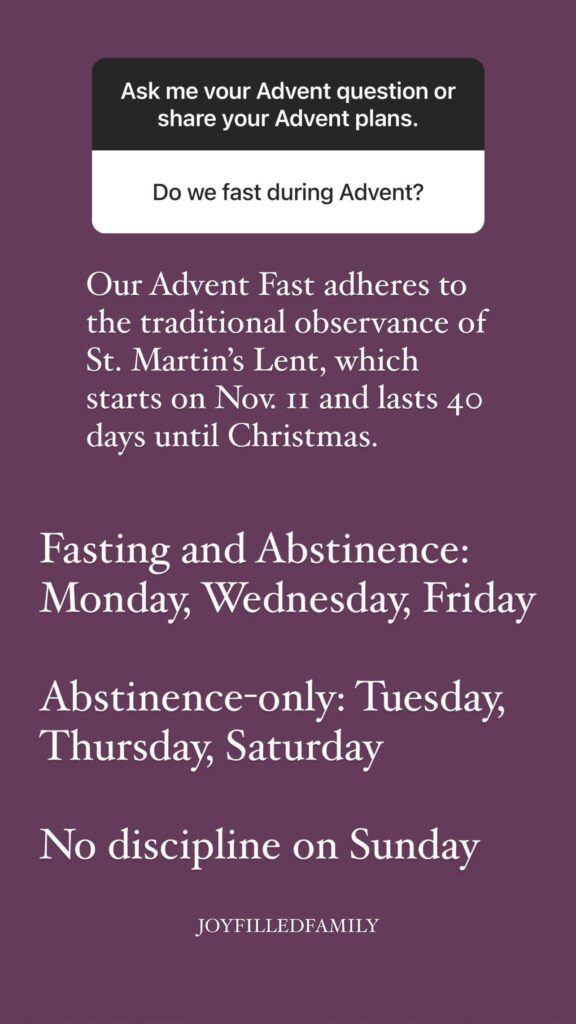
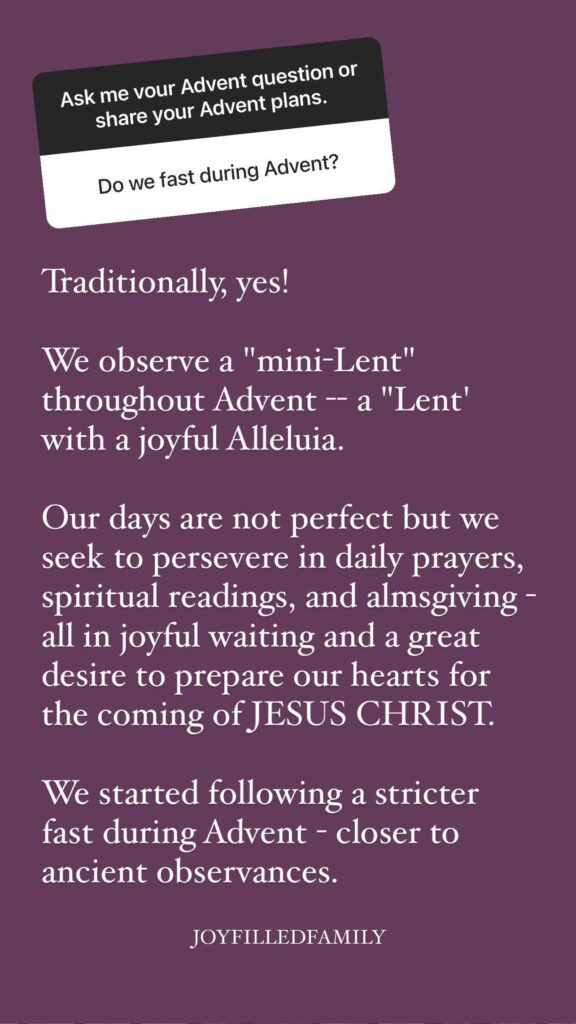
What are some tips for fasting & abstinence during Advent with small children?
We can consider Advent as a long vigil of a big feast. We should desire to really dispose our souls, have the best dispositions possible, for the grace of the feast and for the coming of Our Lord.
This is different than Lent by way of the level of penance since Lent is a time for us to draw closer to His sufferings. Yet, Advent was once referred to as a “Mini-Lent.”
Here some suggestions to implement for children or those who unable to follow stricter fasting & abstinence:
- Limit or refrain from treats outside of Feastdays
- Acts of service (straw in the manger for Baby Jesus’ arrival)
- Spiritual reads or prayer plan
- No meat on Mon., Wed., Fri.
- No media
- No snacking
- Only water for drinks
- Start with Fasting & Abstaining this Advent on the Ember Days (Wed., Fri., and Sat. That follow the Feast of the Holy Cross)
Favorite Advent Activity
Advent Chant – Dad
Reading the Old Testament as a family. – Mom
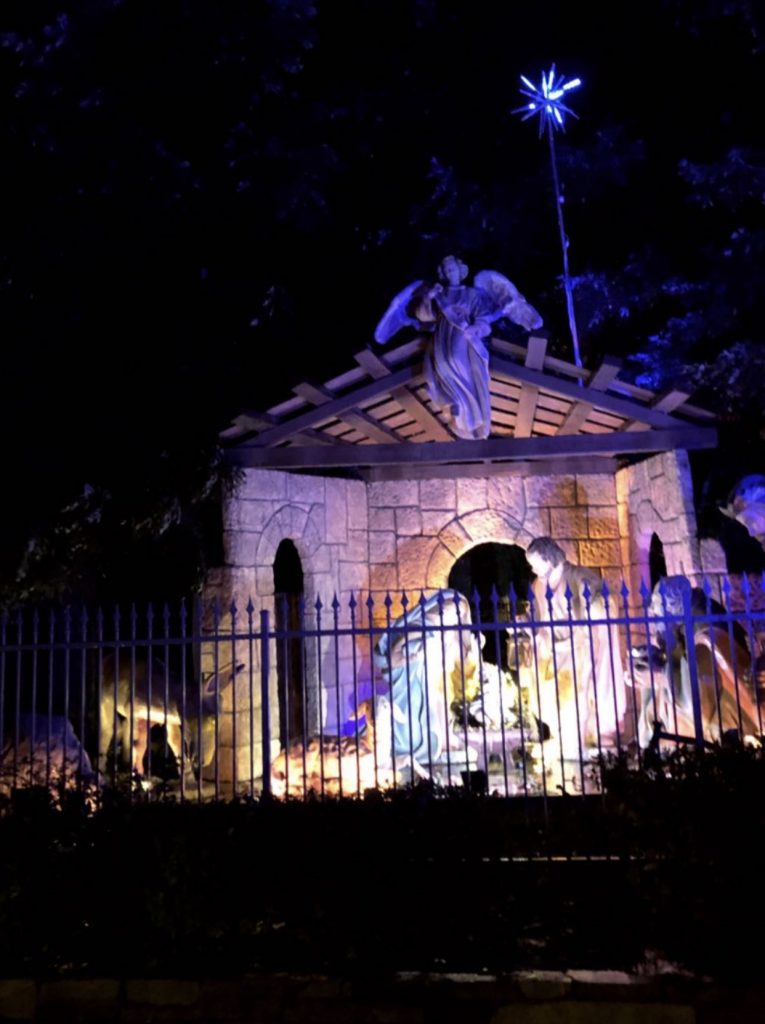
Light Tour on Christmas Lane (neighborhood lit up with Christmas Lights) on the Feastday of St. Lucy. Her name means light; bringer of light and she is the patron saint of all things dealing with eye sight. – 13yo son xx
Cleaning the home (purging) in preparation for the Christ child. – 10yo son
Jesse Tree & Collecting Hay for Baby Jesus’s Manager. -15yo daughter
Displaying the complete Fontni Nativity Set sans baby Jesus thatcher godparents gifted her over the years. – 17yo daughter
Jesse Tree & Journey To Bethlehem. -25yo married daughter
Praying the Christmas Novena everyday of Advent. -7yo son
Our Journey To Bethlehem. -5yo son (who has a birthday on 12.20).

Journey To Bethlehem is an interactive walking tour from the town of Nazareth to Bethlehem. The journey recreates the events that happened on the evening of Christ’s birth. The journey begins as we become a part of a family making a trip to Bethlehem to pay our taxes and be counted under the law of the land.
The trip, which takes about 45 minutes, and is one mile in length, provides us with a glimpse of the events of the times.
Advent Wreath. (The youngest child get the privilege of lighting and blowing out the candles). -3yo son
What resources do you share online?
St. Andrew Christmas Novena Printables & Chaplet Crafts
Christkindl Printable (working on a new one for this year)
O Antiphons Links & Reflections
Immaculate Conception of the Blessed Virgin Mary
What music do you listen to?
We only listen to Advent music during Advent and reserve Christmas music for the entire Christmas season, all 40 days.
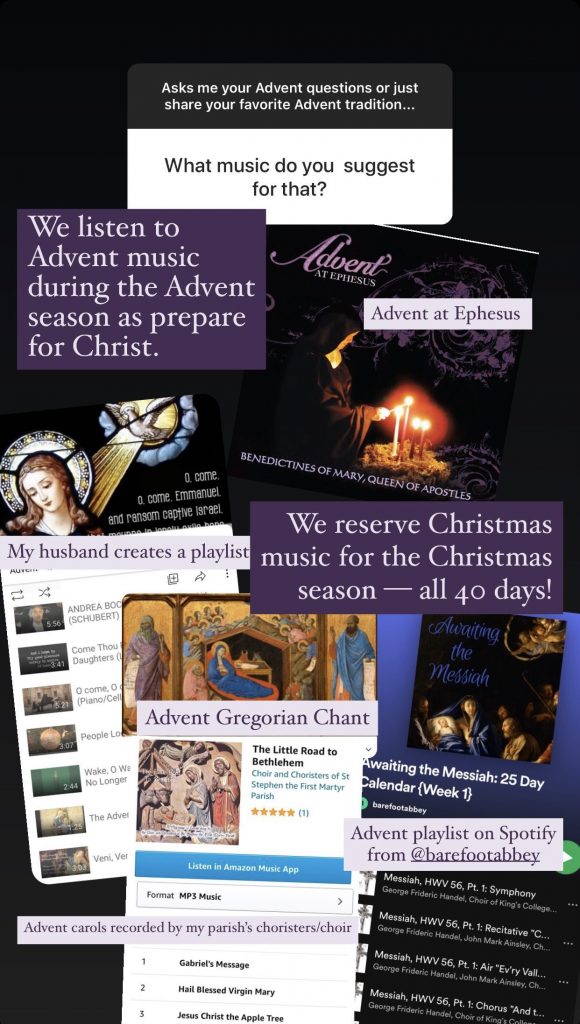
Family Advent Playlists (creates for free online)
Advent Gregorian Chant
Advent Carols & Hymns recorded by our parish’s choristers & choir when our eldest daughter was a member.
Barefootabbey Advent Playlists
Where to begin, it’s my first year year observing Advent?
- Foster a Joyful anticipation & preparation for the coming of Our Lord
- Remove all secular ties to Christmas in your home.
- Save all CHRISTmas decor, music, and the like for Christmas Day and the entire Christmas Season (Candlemas)
- Pray the Divine Office daily if possible or sing O come O come Emmanuel each night after the a rosary (or rotate the seven verses).
- Read Advent Reflections for yourself and guide your children in a daily meditation.
- Select at least one visual activity to help foster the anticipation in your children, especially the littles.
What are your tips to start a Jesse Tree this year?
You can find a trillion options out there, all ranging in price. Below are great resources that I have used for my family (infant to young adults) over the years, all are FREE.
In the future, you can always opt to participate in a Jesse Tree Ornament Swap to get a collection of ornaments.
Jesse Tree Devotional with Traditional Catholic Reflections & Scripture from the Douay Rheims Bible & Cut/Color Jesse Tree Ornaments
Jesse Tree Scripture Readings – FishEaters
Jesse Tree Readings from the New Catholic Picture Bible – Shower of Roses
Printable Jesse Tree Ornaments — Click here for the file and to see how we used this printable. You can also print on card stock, home lunch, place an ornament hook in the hole, and be done!
Have you heard of the Rorate Mass?
Yes, we are blessed to have this Holy Mass offered at our parish every Advent and have been attending for years.
The Rorate Mass is a votive Mass offered within the season of Advent in honor of the Blessed Virgin Mary. Celebrated by candlelight, and traditionally held before dawn.
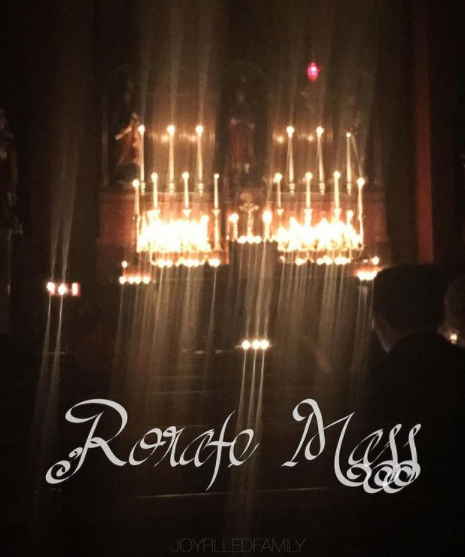
You can read more about it and get a glimpse of the Rorate Mass, here.
How do you balance gift giving to your children and materialism?
We do not do Santa Claus. It is our conviction that Our Lord does not need to have competition. There are enough holy traditions to adopt.
We do not do Christmas gift lists.
We do not put gifts under the tree during Advent.
We do not partake in any celebrations or open any gifts before Christmas Mass.
We do…
Immerse ourselves in scripture
List ways to offer acts of service for the Christ Child. Every time it’s done, a piece of hay/straw/paper is added to an empty manger. The goal is to make it as “comfy” for the Christ Child come Christmas.
The children select a Christkindl. They offer their prayers and random acts of kindness for them throughout Advent. They make or buy a small gift for their Christkindl and exchange it on Epiphany.
We adopt a family in need. We pray for them in a special way throughout Advent and select gifts or items of need for them as we’re able.
We’ve shifted from offering gifts on Christmas Day to giving them on Epiphany.
We hold the Christmas Vigil with holy cheerfulness, fasting, and penance as we prepare for the glorious feast.
After Holy Mass, we return home or wake up (if we attended Midnight Mass) with a party for Jesus — cake and all. Then we open a few gifts from Papa & Nana.
*I will add to this post as more questions come in.
Leave a Reply